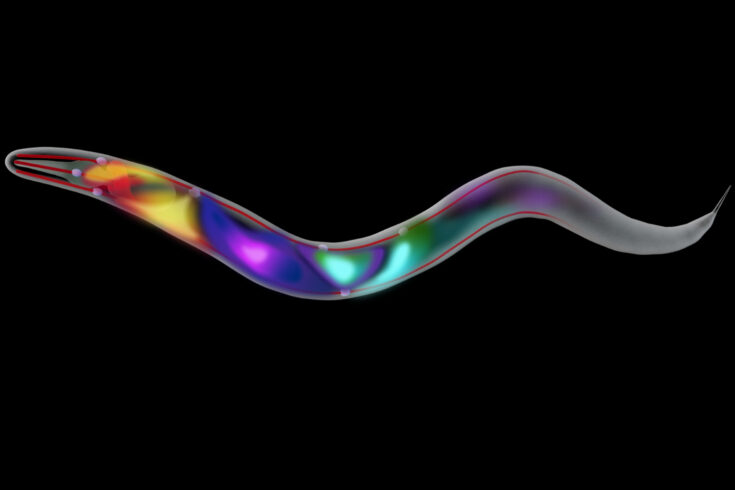Researchers have made a huge step forward in understanding how neurons communicate through extremely short proteins called neuropeptides.
The map, which details 31,479 neuropeptide interactions between the worm’s 302 neurons, shows where each neuropeptide and its receptor acts in the animal’s nervous system.
It will help scientists better understand how widespread neuropsychiatric conditions like eating disorders, obsessive compulsive disorder and post-traumatic stress disorder originate.
Wireless communications
Neuropeptides are signalling molecules produced by neurons that allow them to communicate ‘wirelessly’ with each other, even if the neurons are not immediately next to each other.
As well as generating the first comprehensive map of neuropeptide signalling in a whole animal, the researchers found that the wireless neuropeptide network in C. elegans has a different structure from wired connections. They are denser, more decentralised, and have different key neurons, or hubs.
The wireless network also connects parts of the nervous system that are isolated from the wired connectome.
What is a connectome?
A connectome is a map of the neurons which make up an organism’s brain and the detailed circuitry of neural pathways within it.
As neurons are connected to each other physically by junctions called synapses this connectome can be thought of as ‘wired’.
The C. elegans connectome was mapped in 2019, and since then researchers have been making rapid progress in building connectomes for other simple organisms such as fruit flies.
Recently, researchers studying a fruit fly larvae at the MRC Laboratory of Molecular Biology (LMB) have mapped every single neuron and how they’re wired together.
But until now, no-one had managed to build a map of a wireless neuropeptide connectome in any animal.
Improving our understanding
Since most neurons seem to make both neuropeptides and neuropeptide receptors, the communication pathways formed by neuropeptides make up large neural networks.
These networks are extensive, complex, and critical to the functioning of the brain. As such, they are important for understanding the neuronal basis of behaviour.
Dr William Schafer and PhD student, Lidia Ripoll-Sánchez, both from MRC LMB led the work, together with Petra Vértes of University of Cambridge and Isabel Beets from the University of Leuven in Belgium.
Dr Schafer said:
Neuropeptides and their receptors are among the hottest new targets for neuroactive drugs. For example, the diabetes and obesity drug Wegovy targets the receptor for the peptide GLP-1. But the way these drugs act in the brain at the network level is not well-understood.
The structure of neuropeptide networks suggests that they may process information in a different way to synaptic networks. Understanding how this works will not only help us understand how drugs work but also how our emotions and mental states are controlled.
The idea of mapping these wireless networks has been one of our goals for a long time, but only now have the right combination of people and resources come together to make this actually possible.
C. elegans: a model organism
The worm they studied is called Caenorhabditis elegans or C. elegans for short. It’s harmless, around one millimetre long, and lives in soil.
C. elegans has a very simple anatomy, but it shares many of the essential biological characteristics that are central problems of human biology and widely used by developmental biologists.
Understanding the multi-layered connectome in C. elegans can serve as a ‘model’ for understanding the complex networks that make up larger nervous systems, including the human brain.
Ripoll-Sánchez said:
Basic mechanisms of neuropeptide signalling are shared in all animals: neuropeptides are released from neurons and diffuse to distant areas to bind receptors in other neurons.
The worm’s nervous system is anatomically small, but at the molecular level its neuropeptide systems are highly complex, showing significant parallels to larger animals, and its synaptic connectome shows many features that are conserved in bigger brains.
We expect the neuropeptide connectome of C. elegans will serve as a prototype to understand wireless signalling in larger nervous systems.
Building maps
The researchers built the map by combining biochemical, anatomical and gene expression datasets, using them to determine which neurons can communicate with each other using specific neuropeptide signals.
Once they built this network, they used mathematical models to:
- understand the relationships between these neuropeptide signals
- identify key features as well as neurons with important roles in linking different parts of the network
Jo Latimer, Head of Neurosciences and Mental Health at the Medical Research Council (MRC), said:
This is another exciting and significant body of work by colleagues at the MRC Laboratory of Molecular Biology and others, adding to the connectome work of LMB researchers earlier this year.
Not only have they worked out which neuropeptides act where in the animal’s nervous system, they have discovered that the network is complex, but clearly organised, with an information processing circuit within it.
This is a further important step forward in understanding how brains and nervous systems work, and this increased understanding may have the potential to lead to the future development of targeted therapies for a range of conditions.
Next steps
The next step will be to see whether the principles by which neuropeptide networks in worms are organised also apply in bigger brains.
The researchers are currently working with other collaborators to map wireless neuropeptide networks in animals such as fish, octopuses, mice, and even humans.
Further information
The study was funded by MRC, as well as the European Research Council and the National Institutes of Health and is published in Neuron.

